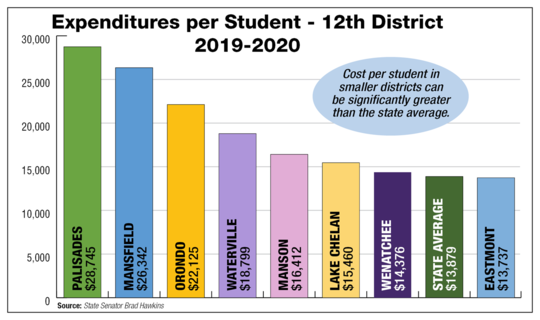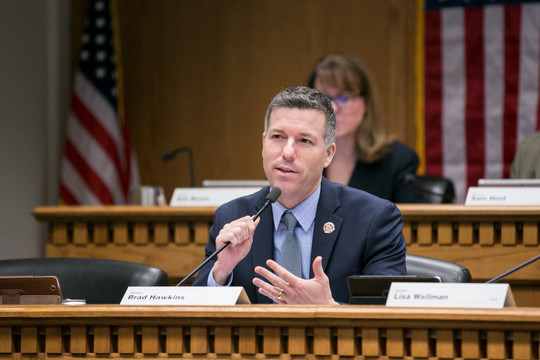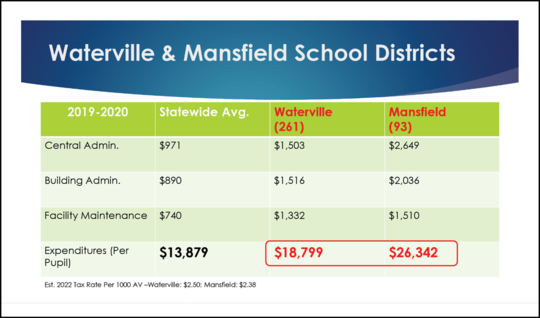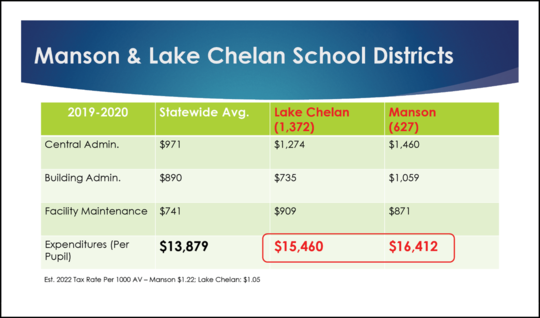January 25, 2022
Dear Friends and Neighbors,
Since the 2012 State Supreme Court’s McCleary decision regarding education funding, the Legislature has significantly increased funding to K-12 education and school districts have also sought expanded property tax levies to fund local schools. The combined revenues have resulted in annual costs of nearly $15,000 per student – on average – across Washington state. In many North Central Washington school districts and throughout other areas of the state, some “per-student” annual costs are much greater than the state average. After studying the data, it appears that smaller school districts have higher “per-student” costs than mid- or larger-sized districts, with much of those higher costs attributable to central administration and maintenance expenses.
 Expenditures in the school districts of Palisades ($28,745 per student), Mansfield ($26,342 per student), Orondo ($22,125 per student), and Waterville ($18,799) are far greater than the statewide average of $13,879 and significantly greater than nearby Eastmont ($13,737 per student).
School districts spending varies by district
School districts do not all spend the same way. Washington state has 295 different school districts. These school districts range from very small districts, such as the Stehekin School District on Lake Chelan with 10 students, to the Seattle School District serving nearly 55,000 students. As a result of local school district control, state funding formulas, and local levy requests, each school district’s expenditures varies. Generally speaking, the cost per student in the small school districts is much higher than those of the medium to larger districts. While smaller school districts may enjoy slightly more flexibility in operations over larger districts, the smaller school districts do not necessarily support lower class sizes or more student options and there is likely an efficiency impact to their operations as well as a cost to the taxpayer. In North Central Washington, for example, the per-student expenditures are higher in the school districts of Palisades ($28,745 per student), Mansfield ($26,342 per student), Orondo ($22,125 per student), and Waterville ($18,799) than the state average of $13,879. Those costs are significantly greater per student than neighboring Eastmont ($13,737), whose average per-student expenditures is below the state average.
 Smaller school districts usually have greater costs per student, often related administration and facility maintenance expenses.
Senate Bill 5487 would incentivize consolidation
I have long wondered why Washington state has 295 different school districts and whether that is the best approach for students and taxpayers. Based on my nearly 10 years as a school board member and my nearly 10 years of experience as a legislator working on education issues, I believe small school districts could potentially benefit from merging with their larger neighboring districts or with similar-sized smaller districts. Strategic consolidation could create more efficiencies for taxpayers by driving down the per-student expenses while expanding options in academics and activities. The issue of school consolidation has certainly been raised before, and it can be controversial. However, past proposals have included the assumption that the state would reimagine district boundaries and force consolidations. My proposal incentivizes voluntary consolidations. Click these links to review Senate Bill 5487 and PowerPoint presentation.
Senate Bill 5487, which was approved last week by the Senate Early Learning and K-12 Education Committee, could help resolve inefficiencies in the per-student expenditures among the smaller districts while helping districts renovate and modernize their facilities, a concern often shared by the smallest districts. My bill concept would temporarily enhance the state’s School Construction Assistance Program (SCAP), which provides matching funds to school districts that pass construction bonds at 60 percent, for smaller school districts that voluntarily consolidate with their neighboring districts. The school facility modernization formula would be enhanced for 10 years following consolidation, so that both the smaller school district and the district it merges into could receive greater state matching dollars for future school facilities. This idea could encourage small school districts to consider voluntary consolidation, create more efficiencies for the taxpayers who fund per-student costs, and assist smaller districts (and their larger neighboring districts) with much-needed modernizations.
 As the ranking Republican member on the Senate’s Early Learning and K-12 Education Committee, I work closely on statewide education policy issues. Prior to being elected to the Legislature, I served for nearly 10 years on the North Central Educational Service District and Eastmont School boards.
Should some local school districts consolidate?
School districts have certainly adapted to many changes in recent years, including adjustments to school funding, remote learning, and COVID protocols. Asking them to take on the additional challenge of voluntarily considering consolidating with a neighboring school district could be a tall order. However, our region has seen recent benefits from consolidations among other local governments, including Wenatchee-based fire districts and the Chelan-Douglas Regional Port Authority. Washington state law (RCW 28A.315.235) provides a clear process for school districts that choose to consolidate, including community votes of the two school districts. Exploring consolidation should include extensive public outreach and engagement. Districts and communities should consider academics, sports, club activities, student transportation, collective bargaining contracts, facilities, local tax structure, school identity, and other factors.
 Waterville and Mansfield are two school districts in our region that could consider joining forces to reduce costs.
The importance of “voluntary” consolidations
As a former school board member for both North Central Educational Service District and the Eastmont School District, I have much respect for local school district control. As a senator, I have taken great efforts to emphasize that my Senate Bill 5487 promotes “voluntary” school district consolidations by offering building construction and modernization incentives. I do not support the state “mandating” school district consolidations. Exploring voluntary consolidations is certainly a conversation some of our local school districts could have with each other. Those discussions could lead to collecting public comment well before any potential community votes. While the decision would ultimately be made locally, after much consideration, the data would suggest that it could be something some of our local districts might want to explore to benefit both students and taxpayers.
 Manson and Chelan school districts both have per-student costs greater than the state average. Given their proximity to each other, could these two school districts function better together?
Listen to my recent local radio interviews
Throughout the legislative session, I call our local radio stations weekly to participate in live interviews about legislative issues. If you'd like to hear my most recent interviews, click on these links for KOHO, KOZI, and KPQ. If you have questions, please contact me anytime.
Thank you for the opportunity to serve as your 12th District state senator.
Sincerely,

Brad Hawkins
State Senator Brad Hawkins
12th Legislative District
Website: senatorbradhawkins.org
107 Newhouse Building - P.O. Box 40412 | Olympia, WA 98504-0412
(360) 786-7622 or Toll-free: (800) 562-6000
|